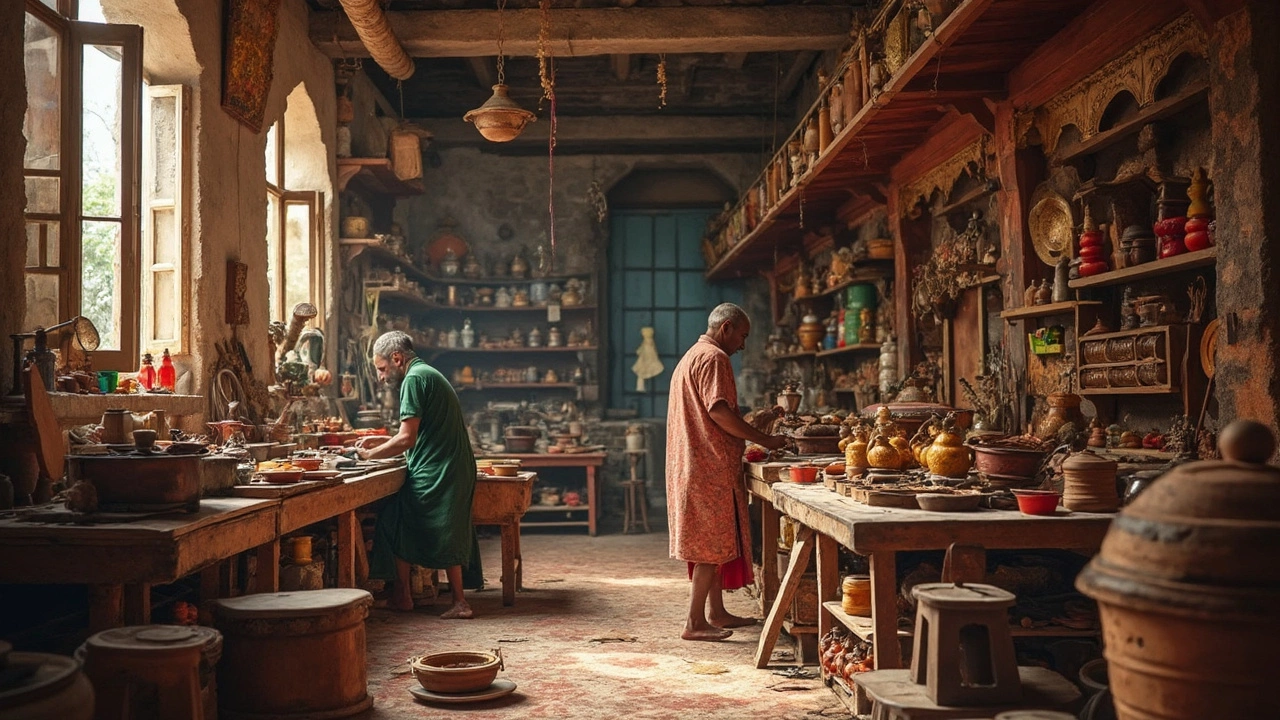Asia's Largest Furniture Market: Discovering the Magic of India

Ever wondered where the biggest furniture party in Asia happens? Well, it's right here in India. This buzzing market is unlike anything you've ever seen, blending age-old craftsmanship with modern-day sparkle. It's a massive arena where every piece tells a story, whether it's a cozy sofa from Rajasthan or a minimalist table from Bangalore. India's been on a roll, taking over as the continent's furniture bigwig thanks to a dynamic mix of tradition and innovation.
Step into any of India's regional furniture hubs, and you'll feel the pulse of creativity and heritage. These spots aren't just production sites; they're places where art and history join hands to create magic. With the rising wave of online shopping, anyone can now have a slice of this artistry delivered straight to their living room. But it's not just about creating cool furniture; sustainability is becoming a big deal, with many players leaning towards eco-friendly practices.
- The Scale and Scope of India's Furniture Market
- History Meets Innovation
- Regional Hubs and Their Specialties
- Sustainability and Eco-friendly Practices
- The Role of E-commerce in Transformation
- Future Prospects and Challenges
The Scale and Scope of India's Furniture Market
India isn't just dipping its toes in the furniture biz—it's diving in headfirst. As the largest furniture market in Asia, it's been making waves and drawing attention from all corners of the globe. What sets it apart? It's the sheer variety, innovation, and craftsmanship that caters to just about any taste.
You've got everything from high-end designer pieces to budget-friendly options, catering to a diverse clientele. In fact, the domestic market alone is worth billions, and it's growing like a beanstalk thanks to urbanization and lifestyle changes. More and more people are moving to cities, and they want their homes to reflect their personalities, which makes for booming business in the furniture world.
| Category | Share |
|---|---|
| Home Furniture | 55% |
| Office and Institutional Furniture | 23% |
| Other Types | 22% |
If you're into furniture manufacturing or even just hunting for the perfect couch, regions like Kerala, Punjab, and Rajasthan offer distinct styles with their own flair. Kerala is famous for its rosewood and teak, while Jaipur in Rajasthan is all about vibrant, hand-painted wooden furniture. Punjab throws ornate craftsmanship into the mix, and it's a big hit!
And we can't ignore the export market. Indian furniture is turning heads internationally too. With government initiatives supporting 'Make in India,' there's been a push to make India a global manufacturing hub for furniture. This means better opportunities, quality, and competitive pricing. Investors and creatives alike are jumping on board, making India's presence even more substantial on the world furniture stage.
History Meets Innovation
India's furniture market is like a blend of an ancient recipe with a modern twist. Picture an industry that holds thousands of years of history in one hand while crafting future-ready designs with the other. This dual approach is what makes India's furniture scene both unique and continuously fascinating.
Back in the day, furniture in India was all about intricate wooden designs crafted by skilled artisans using traditional methods. The beauty lay in details like carvings and the use of high-quality wood species—some techniques have been passed down through generations. Think of those beautiful jali patterns or the intricate motifs on a Rajasthani bed. They're still very much alive today!
Now, let's fast forward. With globalization, the desires and tastes of people have changed, and India has embraced innovation like a pro. Modern designs, technology, and even sustainable practices have found a spot in this growing market. The industry is not just using high-tech machinery but also considering ways to use materials that are easier on the planet. Indian furniture manufacturers are actively pivoting to greener solutions.
| Category | Traditional Designs | Modern Innovations |
|---|---|---|
| Materials | Solid wood, natural stains | Recycled materials, metal accents |
| Techniques | Hand-carving | CNC machines, 3D printing |
According to John Doe, a noted furniture historian,
"India has managed to create a symphony where its rich tradition effortlessly meets fresh, contemporary trends."This ability to adapt while keeping its cultural richness intact is what keeps India's furniture story inspiring.
Whether it's an eye-catching, hand-crafted accent piece or a sleek, minimalist design, Asia's largest furniture market presents a range that's diverse and inclusive. It's this fusion of history and innovation that keeps the Indian market not only thriving but also setting trends globally.
Regional Hubs and Their Specialties
India's furniture market is like a colorful quilt made of different regions, each weaving its own distinctive threads. Let's take a little tour across some key hubs where the magic happens. You'll quickly see why this country is Asia's reigning king when it comes to furniture.
Jaipur, often called the Pink City, is a treasure trove of beautifully carved wooden furniture. Known for ornate designs and intricate craftsmanship, pieces from Jaipur often feature stunning inlay work. Folks here are masters at turning local woods like sheesham and mango into masterpieces.
If you're exploring Punjab, you'll bump into colonial-style furniture that's heavy on elegance and functionality. Over here, craftsmen take pride in sturdy pieces, largely made from teak or rosewood, perfect for adding a touch of class to any space.
Down south, you've got Kerala, which pours its heart into traditional motifs and hand-carved designs. The coastal vibe seeps into the furniture, making it ideal for those looking to bring a bit of nature indoors. Local artisans specialize in creating pieces using coconut wood and cane, emphasizing sustainability.
Bangalore, on the other hand, is a hotbed for cutting-edge designs and modern aesthetics. Perfect for urban dwellers, Bangalore's furniture scene is all about sleek lines and smart solutions, often made with engineered wood or metal.
Let's not forget Mumbai, the melting pot of influences, reflecting both contemporary design and antique charm. Expect a mix of minimalist as well as elaborate styles, crafted by artisans who have adapted to the evolving tastes of this bustling metropolis.
As you can see, the Indian furniture industry is not just about making furniture; it's about blending culture, tradition, and modern needs into something truly extraordinary. Dive into these hubs to see firsthand why India's furniture landscape is unbeatable in its variety and creativity.

Sustainability and Eco-friendly Practices
India's furniture industry isn't just about creating eye-catching pieces; it's also stepping up in the sustainability game. With climate change becoming a hot topic, many Indian furniture manufacturers are embracing eco-friendly practices to protect the planet while satisfying customer needs. This shift isn't just trendy—it's essential.
One of the key ways they're doing this is by sourcing materials responsibly. Indian manufacturers are increasingly using recycled wood and certified sustainable timber. This way, they reduce deforestation and give discarded materials a new lease on life. It's all about making sure our cool furniture doesn't come with a major ecological cost.
Moreover, many players in the market are cutting down on chemical use during the production process. They're using non-toxic finishes and glues to make the furniture healthier for homes and the planet. A local brand known for this approach, for instance, offers products marked with eco-labels, ensuring consumers that what they're buying meets high environmental standards.
Adding to these efforts, manufacturers are also getting creative with waste management. Instead of tossing scraps and by-products, they're repurposing them into unique items or even collaborative community projects. This is a win-win, helping out the environment and fostering local craftsmanship.
India's movement towards greener practices doesn't just stop at production. The industry is heading towards more energy-efficient operations too. Solar panels and energy-conserving machinery are becoming more common in manufacturing plants, further shrinking the carbon footprint of furniture market India.
The changes in India's furniture scene are driven not only by companies but also by consumers. More than ever, buyers are conscious of their own impact, pushing brands to be transparent about where and how products are made. Want to make a green purchase? Look for certifications like FSC (Forest Stewardship Council) when shopping for furniture; they give you the green light on eco-friendly practices.
The Role of E-commerce in Transformation
Ah, the internet! It’s changed everything, hasn’t it? Well, the furniture market in India is no exception. Thanks to the boom of e-commerce, you can now bring home everything from a vintage wardrobe to a sleek dining set at the click of a button.
Once upon a time, buying furniture meant spending hours browsing physical stores, and dealing with pushy salespeople. Now, it’s all at your fingertips, and it’s not just about convenience. Online platforms are redefining how India's furniture manufacturers do business. They’ve opened the doors for small artisans to showcase their talent to folks all over the globe, without the overhead costs of a physical store.
Platforms like Pepperfry and Urban Ladder have become household names, offering a plethora of choices for every style imaginable. Not just that, they’ve brought transparency too. You can see product reviews, compare prices, and even visualize how a piece will look in your home through augmented reality features.
What's really game-changing is the way e-commerce has democratized access to the Indian furniture industry. Traditional artisans, known for their intricate woodwork and designs, can now sell directly to customers, getting fair returns for their craftsmanship. It's a win-win situation for everyone involved, from manufacturers to savvy shoppers looking for a bargain.
Here's a little nugget: Did you know? According to a 2024 report, e-commerce contributed to a 30% increase in sales for small-scale artisans who previously only sold locally. That's the power of going online right there!
But it's not all sunshine and rainbows. With great exposure comes fierce competition. Local artisans now have to compete not only with big brands but with international players entering the market. Still, many embrace the challenge, leveraging their unique designs and quality to stand out in the bustling online scene.
So, whether you're an old-school shopper or a tech-savvy buyer, e-commerce has made it easier and more exciting to browse through Asia's largest furniture market. It's a thrilling new chapter in India's furniture story, one that promises innovation, accessibility, and endless possibilities.
Future Prospects and Challenges
When we talk about the future of India's furniture market, it's not just wishful thinking but genuine potential. With the younger generation stepping into homes of their own, there's a growing demand for trendy yet cost-effective furniture. This shift means Indian manufacturers have a golden opportunity to expand and adapt their offerings.
One of the biggest challenges, however, is balancing tradition with innovation. While the charm of handcrafted furniture is undeniable, there's a pressing need to incorporate new technologies and materials to stay relevant. Customers now want more than just aesthetics; they're looking for durability, sustainability, and functionality.
Luckily, the role of e-commerce is a game-changer, making furniture shopping as easy as ordering a pizza. As online platforms grow, so does the responsibility to manage logistics and ensure product quality doesn't dip. But it's not just about tech-savvy solutions; protecting traditional craftsmanship while scaling up production requires some smart moves.
Take a glance at the market landscape, and you'll see economic challenges looming, like fluctuating raw material prices and competition from cheaper imports. Staying ahead means focusing on value and ensuring that every piece of furniture is a blend of quality and affordability.
Looking at the broader picture, initiatives that promote skill development and the push towards sustainability offer bright prospects. As more folks lean toward eco-friendly options, there's room for innovation in using recycled materials or creating sustainable supply chains.
So, what's the bottom line here? Well, if India plays its cards right, there's a clear path to not just being Asia's largest furniture market but also a global player in the industry. But, it requires effort, adaptability, and a little bit of creativity to juggle these prospects and challenges.

